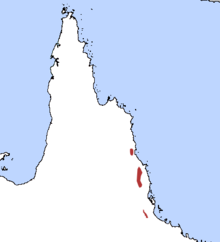Rust-colored broad-footed pouch mouse
| Rust-colored broad-footed pouch mouse | ||||||||||||
|---|---|---|---|---|---|---|---|---|---|---|---|---|
| Systematics | ||||||||||||
|
||||||||||||
| Scientific name | ||||||||||||
| Antechinus adustus | ||||||||||||
| ( Thomas , 1923) |
The rust-colored broad -foot pouch mouse ( Antechinus adustus ) is a species of marsupial from the genus broad-foot pouch mice that occurs in the Atherton Tablelands in the Australian state of Queensland . The coastal, non-contiguous distribution area has a north-south extension of about 325 km and is less than 20 km wide.
features
The males of the rust-colored broad-footed pouch mouse have a head-trunk length of 9.4 to 12.5 cm, a 9.1 to 10.4 cm long tail and weigh 28 to 42 g. Females stay slightly smaller with head-to-trunk lengths of 8.8 to 10.9 cm, tail lengths of 7.2 to 10.1 cm and a weight of 18 to 35 g. The pouch mice are colored a solid dark brown, caused by dark hair tips. Dark circles under the eyes or reddish cheeks as can be seen in the Queensland broad-footed pouch ( Antechinus godmani ), which occurs in its area, are missing. The dark, long fur distinguishes the rust-colored broad- foot bag mouse from the yellow-foot bag mouse ( Antechinus flavipes ), the mystical broad -foot bag mouse ( A. mysticus ), the subtropical broad -foot bag mouse ( A. subtropicus ) and the Stuart broad- foot bag mouse ( A. stuartii ).
Habitat and way of life
The rust-colored broad-footed bag mouse occurs in relatively cool, undisturbed rainforests above 600 meters. It builds nests from leaves, moss and lichen in tree hollows in the middle and upper areas of the trees. Rust-colored broad-footed bag mice feed on moths, cockroaches, flies, beetles and spiders, and sometimes also on small vertebrates such as frogs or skinks or on carrion. The prey animals are caught in the trees and bushes as well as on the ground. In contrast to most other broad -footed pouch mice, the rust-colored broad -footed pouch mouse is diurnal, possibly to avoid competition with the nocturnal and larger species of yellow-footed pouch mouse and Queensland broad-footed pouch mouse. Rust-colored broad-footed pouch mice mate from May to July and the young are born from June to August. The females have six teats in the bag and an average of 4.2 young animals are born per litter. These are weaned in December or January when the humidity and temperature rise and insects are particularly frequent. As is usual with broad-footed pouch mice, all males of the rust-colored broad-footed pouch mouse die shortly after the mating season from stress-related diseases. Well-known predators of the rust-colored broad- footed pouch mouse are house cats, the boobook owl ( Ninox boobook ) and the spotted soot owl ( Tyto multipunctata ), but bones of the animals are rarely found in the crests of the two owl species due to their activity during the daytime.
Systematics
The rust-colored broad -footed pouch mouse was scientifically described for the first time in 1923 by the British zoologist Oldfield Thomas under the name Phasogale flavipes adusta , i.e. as a subspecies of the yellow-footed pouch mouse (then Phasogale flavipes ). Later it was long considered a subspecies of the Stuart broad- footed pouch mouse ( Antechinus stuartii ). It has only been considered an independent species since 2000 because of its longer and darker fur and a different skull morphology.
Danger
The IUCN lists the rust-colored broad-footed pouch mouse as least concern (not endangered).
Individual evidence
- ↑ a b c d Andrew Baker: Family Dasyuridae (Carnivorous Marsupials). in Don E. Wilson , Russell A. Mittermeier : Handbook of the Mammals of the World - Volume 5. Monotremes and Marsupials. Lynx Editions, 2015, ISBN 978-84-96553-99-6 , page 309.
- ↑ Antechinus adustus in the IUCN Red List of Threatened Species 2013.1. Posted by: Burnett, S. & Winter, J., 2008. Retrieved October 12, 2013.
